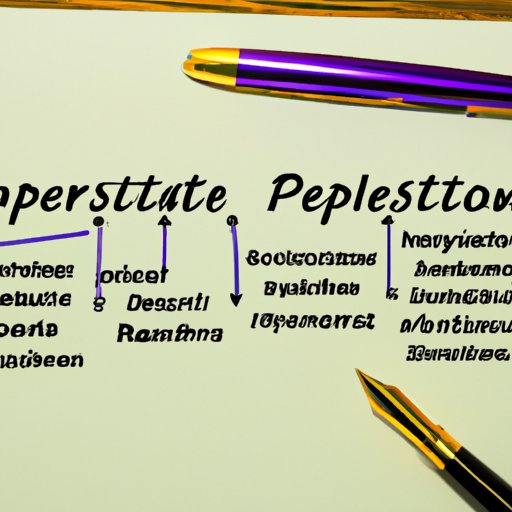Introduction
Probate is the legal process of administering an estate after a person has passed away. It involves identifying and gathering the deceased’s assets, paying debts, taxes and expenses, and distributing remaining assets to the designated beneficiaries. The process can be complicated and lengthy, so it is important to understand how it works in order to ensure that the estate is handled correctly and efficiently.
Exploring the Basics of Probate: A Step-by-Step Guide
The probate process typically follows these steps:
- Identifying and locating estate assets
- Filing a petition with the court to open the estate
- Notifying creditors and other interested parties
- Gathering assets and determining their value
- Paying debts, taxes and expenses
- Distributing remaining assets to the beneficiaries
To complete these steps, you will need certain documents and information, including the will, death certificate, and any asset or debt records. You may also need to obtain an employer identification number (EIN) from the IRS, as well as a tax clearance certificate from the state’s taxing authority. In addition, you may need to hire professionals, such as a lawyer, accountant, or appraiser, to assist with the process.

An Overview of Probate: What You Need to Know
There are two types of probate proceedings: formal and informal. Formal proceedings require court supervision and involve more paperwork and court appearances. Informal proceedings do not require court supervision and are usually simpler and less expensive.
The executor or administrator of the estate is responsible for carrying out the probate process. They must identify and contact all of the beneficiaries, as well as handle all of the paperwork and legal requirements associated with the process. If there is no will, the court will appoint an administrator to oversee the estate.

Breaking Down the Process of Probate
The first step in the probate process is filing a petition with the court to open the estate. This petition must include the names of the decedent and the proposed executor/administrator, as well as a list of the decedent’s assets and debts. The court will then issue letters of administration or letters testamentary, which authorize the executor/administrator to manage the estate.
Once the estate is opened, the executor/administrator must notify creditors and other interested parties, such as government agencies and heirs. They must also gather all of the decedent’s assets and determine their value. Depending on the size of the estate, they may need to hire experts, such as appraisers and accountants, to assist with this process.
The executor/administrator must then pay any outstanding debts, taxes and expenses before distributing the remaining assets to the beneficiaries. This distribution must be done according to the instructions in the will or, if there is no will, according to state law.

Unpacking the Complexities of Probate
While the probate process is designed to be straightforward, there are some potential complications that can arise. For example, disputes between beneficiaries may occur if one beneficiary believes they are entitled to more than they received. Additionally, creditors may attempt to collect debts that have already been paid, or the executor/administrator may make mistakes in the process that can lead to costly delays and legal issues.
To avoid these issues, it is important to understand the probate process and to seek professional advice when necessary. An experienced attorney can help you navigate the complexities of the process and ensure that all legal requirements are met.
Navigating Probate: A Comprehensive Guide
Probate can be a complex and time-consuming process, but there are some steps you can take to make it smoother. Here are some tips for navigating the process:
- Stay organized. Create a file for each estate asset and keep track of all paperwork related to the probate process.
- Communicate with beneficiaries. Keep them informed of progress and respond promptly to any questions they may have.
- Seek professional advice. Hire an attorney or financial advisor if you need assistance with the process.
- Utilize available resources. There are many online resources available to help you understand the probate process.
Probate can be a daunting process, but with the right guidance and resources, it can be made much easier.
Conclusion
Probate is the legal process of administering an estate after a person has passed away. It involves identifying and gathering assets, paying debts, taxes and expenses, and distributing remaining assets to the designated beneficiaries. The process can be complex and time-consuming, but understanding the basics and utilizing available resources can help make it smoother.
(Note: Is this article not meeting your expectations? Do you have knowledge or insights to share? Unlock new opportunities and expand your reach by joining our authors team. Click Registration to join us and share your expertise with our readers.)
